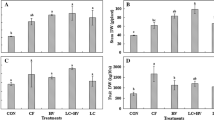Abstract
A 6-year field study was conducted to compare the effects of 11 N-P-K fertilizer formulations and five N sources applied to two rabbiteye blueberry (Vaccinium ashei Reade) cultivars. Fertilizers containing only ammonium nitrate (AMMN) and double rates of AMMN reduced ‘Tifblue’ yields during the first three production years when compared to no fertilizer applied. Each of the fertilizers, azalea-camellia (A-C), commercial grade 5-10-10 (COMM), and cottonseed meal (CSM), increased ‘Tifblue’ yields over the control group beginning the sixth year in the field. Various fertilizers applied did not improve ‘Woodard’ yields throughout the 6-year experimental period. At plant age 8, fertilizer formulations 1-0-0 and 2-1-1 (oxide basis) caused significant yield reduction. Fertilizer formulations did not influence fruit size of either ‘Tifblue’ or ‘Woodward’ significantly over the 6-year period. N-P-K fertilizers 1-1-1 and 2-2-2, A-C and COMM increased growth of 7-year-old ‘Tifblue’ plants. AMMN, A-C, COMM, and CSM enhanced ‘Tifblue’ foliage color score. However, only A-C improved the color of ‘Woodard’. N sources AMMN, ureaform (URAM), and urea (UREA) in fertilizer formulations containing N decreased yield on 4- and 5-year-old ‘Tifblue’ and ‘Woodard’ plants, but AMMN increased ‘Tifblue’ yield on 7-year-old plants. Fertilizing ‘Tifblue’ with A-C, COMM, or CSM would increase return from fruit sale by $3080·ha−1, but applying 1-0-0 or 2-1-1 would decrease grower's profit by 40 to 60%. There was no yield or dollar return benefit from fertilizing ‘Woodard’ plants grown on a virgin acidic soil, but there was an indication (statistically non-significant0 of increased yields with potassium sulfate, A-C, COMM, and CSM after seven years of age. These results indicated that: (1) blueberry response to fertilizers varied from year-to-year, (2) genetic differences exist among blueberry cultivars in response to type of fertilizer applied, (3) rabbiteye blueberry plants do not benefit from high oxide base levels of available N in an N-P-K fertilizer, and (4) fertilizer requirements of rabbiteye blueberry plants need to be evaluated over an extended period of time to obtain a reliable response.
Similar content being viewed by others
References
Austin ME and Mullinix BG (1980) Plant populations and fertility studies on rabbiteye blueberries. J Amer Soc Hort Sci 105: 111–114
Austin ME (1982) An observation on rooting depth of rabbiteye blueberry plants. Georgia Agric Exp Res Rpt 394
Austin ME and Bondari K (1986) Effect of fertilizer applications, plant age, and rainfall on the yield and fruit size of rabbiteye blueberry clone T-110. J Amer Soc Hort Sci 111: 840–844
Bailey JS, Gersten B, Valach E and Olanyk GW (1966) Response of Rubel blueberry bushes to ammonium sulfate and sulfate of potash-magnesia. Proc Amer Soc Hort Sci 89: 237–242
Creech D and Wharton T (1987) Blueberry studies reveal ‘there's no such thing as fertilization recipe’. Fruit South 8: 6–8
Cummings GA, Mainland CM and Lilly JP (1981) Influence of soil pH, sulfur, and sawdust on rabbiteye blueberry survival, growth, and yield. J Amer Soc Hort Sci 106: 783–785
Davies FS, Teramura AH and Buchanan DW (1979) Yield, stomatal resistance, xylem pressure potential, and feeder root density in three rabbiteye blueberry cultivars. HortScience 14: 725–726
Moore JN (1971) Blueberry variety performance in Arkansas. Univ Ark Exp Stn Rpt Ser 186
O'Dell CR (1988) Blueberry fertilization. Amer Fruit Grower 108: 44
Patten KD, Haby VA, Leonard AT, Neuendorff EW and Davis JV (1988) Nitrogen source effects on rabbiteye blueberry plant-soil interactions. Commun Soil Sci Plant Anal 19: 1065–1074
SAS Institute, Inc (1985) SAS user's guide: statistics, version 5 edn, Cary, North Carolina
Scott DH, Draper AD and Darrow GM (1978) Commercial blueberry growing. Farmers' Bull 2354 USDA-SEA, Washington, DC
Spiers JM (1978) Effect of pH level and nitrogen source on elemental leaf content of ‘Tifblue’ rabbiteye blueberry. J Amer Soc Hort Sci 103: 705–708
Spiers JM (1979) Calcium and nitrogen nutrition of ‘Tifblue’ rabbiteye blueberry in sand culture. HortScience 14: 523–525
Spiers JM (1979) Influence of oxidized and reduced N on ‘Tifblue’ rabbiteye blueberry growth: 64–67. In: Moore JN (ed) Proc 4th North Amer Blueberry Res Workers Conf Univ Arkansas, Fayetteville, Arkansas
Spiers JM (1982) Fertilization, incorporated organic matter, and early growth of rabbiteye blueberries. J Amer Soc Hort Sci 107: 1054–1058
Spiers JM (1983) Influence of N, K, and Na concentration on growth and leaf element content of ‘Tifblue’ rabbiteye blueberry. HortScience 18: 223–224
Spiers JM, Braswell JH and Hegwood CP (1985) Establishment and maintenance of rabbiteye blueberries. MAFES Bull 941
Spiers JM (1987) Fertilization of rabbiteye blueberries grown on a typic paleudutt soil. J Plant Nutrition 10: 2247–2261
Tamada T and Iwata M (1975) Effect of the different forms of nitrogen and ph levels on the growth of rabbiteye blueberry in sand culturer. Proc Jpn Soc Hort Sci: 104–105
Townsend LR (1973) Effect of N, P, K, and Mg on the growth and productivity of the highbush blueberry. Can J Plant Sci 53: 161–168
Author information
Authors and Affiliations
Rights and permissions
About this article
Cite this article
Austin, M.E., Bondari, K. Studies on the response of ‘Tifblue’ and ‘Woodard’ rabbiteye blueberries to fertilizers. Fertilizer Research 20, 173–180 (1989). https://doi.org/10.1007/BF01054553
Received:
Accepted:
Issue Date:
DOI: https://doi.org/10.1007/BF01054553




